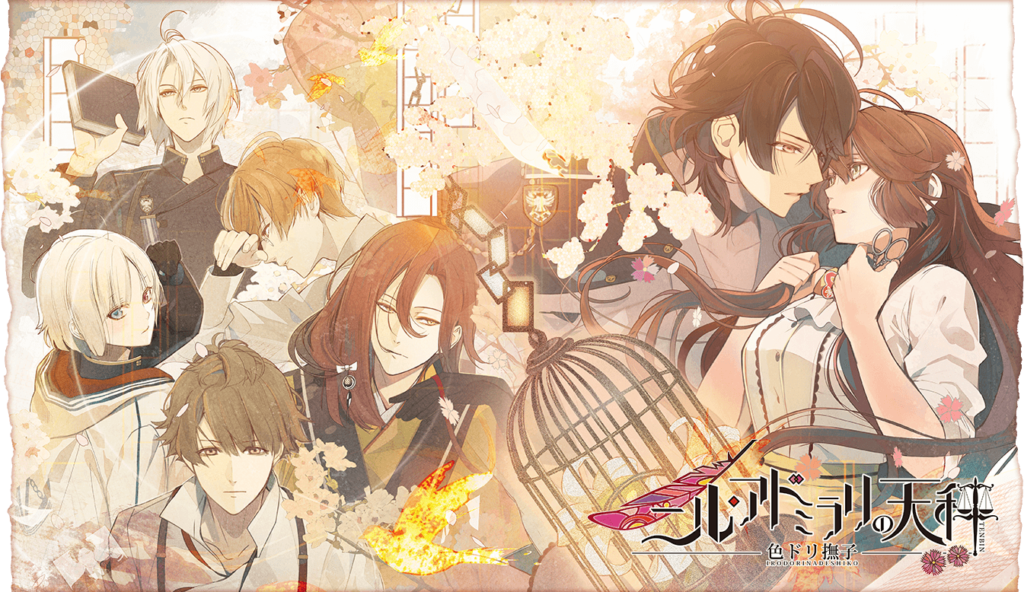This game is otome comfort food through and through
Setting
In the Taisho era in Tokyo the MC Tsugumi lives as a well-behaved daughter of a former wealthy family and is supposed to marry off for financial reasons. But her life suddenly changes, as her brother tries to commit suicide, but it’s soon found out, that he didn’t quite act out of his own free will, but rather was influenced by a handwritten book into attempting suicide. And Tsugumi’s brother is not the only one who suffers that fate. There are actually similar cases of people driven into madness or suicide by handwritten books, called maremono. Shortly after this incident Tsugumi is visited by two men who introduce themselves as practically the book police, Fukurou, who is responsible to solve and prevent those book murder cases by finding and handling those maremono. And after the shock of seeing her brother in flames Tsugumi developed the ability to see the aura of maremono, meaning to make them out within one glance, and therefore joins this organisation and starts living together with them. And discovers what life outside her sheltered home looks like.
And what is more part of a coming of age story than falling in love with either of those 6 people?!
The common route took me about 7hrs and likewise did each character route.
Characters
Shougo

A rich student who was also made to attempt suicide by a maremono and therefore temporarily lives in the same apartment as the members of the Fukurou. He is a spoiled brat, and really a cliché rich kid and sexist snob and on top of that a total tsundere. So most of the time he seems childishly angry and can be hurtful towards the MC. On the other hand his dere side is not too strong either, so he’s actually rather tsuntsun, without the dere.
His route was a good introduction into the world of characters, as you are sent to investigate and obscure club “Nachtigall”, that is said to deal maremono (cursed books). On top of this suspenseful undercover mission, it was quite fun to see Shougo’s childish reactions and pouting.
Hisui

Hisui is another character with magical powers being able to make flames. He is described to be as pretty as an angel, and apart from that is rather calm and friendly, likes to study languages or do little manual handy man things. But he’s also extremely self-conscious, what will make a huge part of his story.
Though I found his character a bit annoying with his self-consciousness, I definitely enjoyed his route, as it showed another side of the maremono, while looking for the author of a specific maremono, Hisui might have a special connection to.
Shizuru
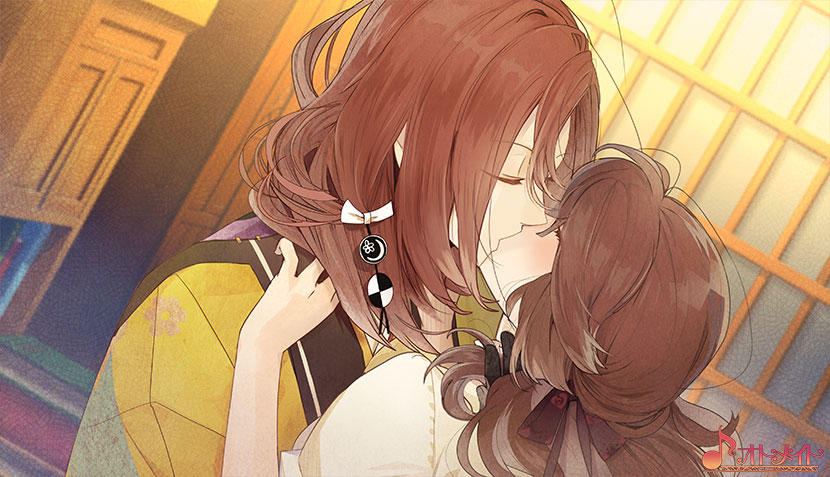
Shizuru is a relatively famous writer and the play boy of the bunch, who constantly makes sexual allusions and teases the MC. But this flirtatiousness makes the conversations with him highly amusing and entertaining. And still he has a modern world view, for example wanting women to vote.
His route was one of my favourites. In his route strange murder cases started to occur, not connected to maremono, but every female victim is found with lavender in her mouth and a book of Shizuru nearby, who always smells like lavender…. On top of this poetic mystery, I really could relate how they fell in love and the ending felt totally wholesome.
Akira
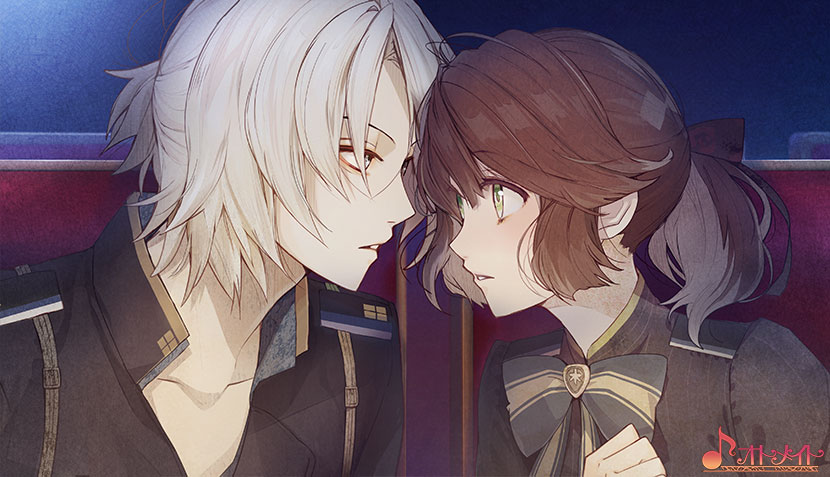
Bless the otome gods, for giving me so much of Yang’s voice actor the past weeks. I heard him in Cupid Parasite, Variable Barricade and now Nil Ado, and of course I love him and inevitably the characters he voices and I’m not sorry for my evident bias!
Ok, Akira is sadly in general a more silent character, who seems disinterested, yet not impolite. He’s kind of reclusive and unsociable, and describes himself as bad with people. Though actually he is quite sensitive and observant.
And oh, his route <3 I love a route when it somehow finds a way to force the MC and LI to stay together permanently, after someone seems to try to kidnap Tsugumi. We spend a lot of time with Akira in his route and I loved every second of it. The process of him slowly falling in love without noticing it and all their cute first date moments like coincidentally touching hands and blushing – that’s the kind of romance story I want! But still his route had a twist that let you doubt your judgement of him and surely can be controversial.
After those four characters Rui gets unlocked
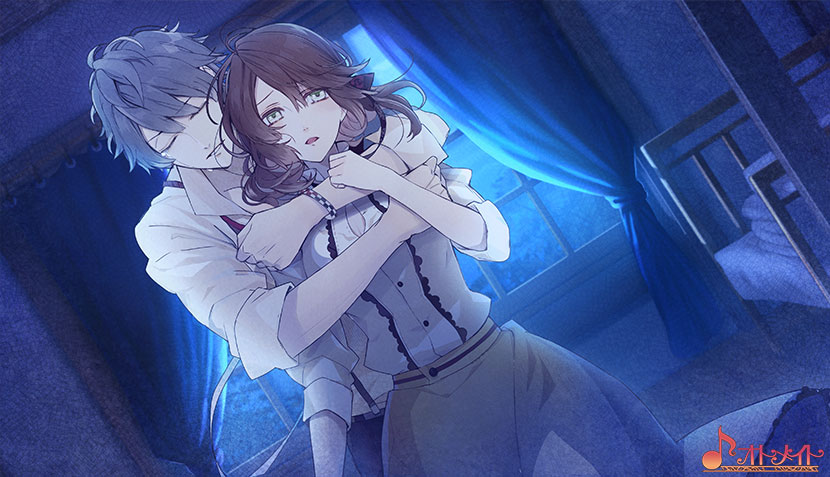
He’s not part of the Fukurou, but a rational medical student, who is confident and outspoken, I couldn’t decide whether he was plain boring or so boring that he was suspicious again.
His route had the most interesting character development and interesting choices, concerning a student movement agains maremono, that led to different outcomes, so the endings branched relatively early, what makes for an interesting alternative story about revenge and redemption.
After him you can finally play the poster boy Hayato
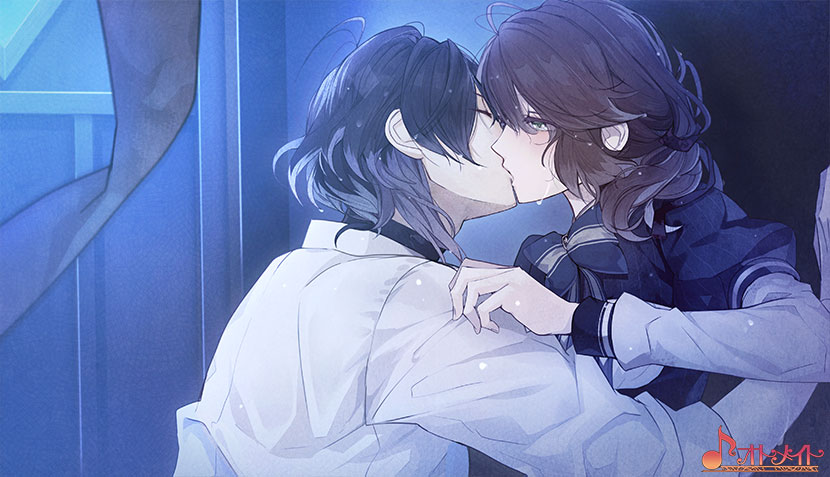
And already in the common route I noticed that Hayato is not the usual boring poster boy. But he’s rather extremely charming and almost like a bright genki boy, but without being naively childish, but just a bit quick tempered and honest, saying just what comes to mind and blushes easily. He’s just a genuine great guy and there are some scenes that totally reminded me of my boyfriend, how he wanted to tease the MC and laugh about her cuteness while she was highly embarrassed. So obviously he’s boyfriend material!
His route advanced a bit faster than the other ones in my impression and had some new revelations up its sleeve. And especially the ending was lovely.
And he gets most sexy award, he earned it!
Art
Voices
As always the voice acting was well executed. I want to mention especially Shougo (Kimura Ryouhei木村 良平: Nicola in Piofiore, Gil in Cupid Parasite), and of course Akira (Okamoto Nobuhiko岡本 信彦: Yang in Piofiore, Peter in Cupid Parasite) and Hayato (Kaji Yuuki梶 裕貴: Ryouta in Tokimemo 4)
Shizuru (Suzumura Ken’ichi鈴村 健一: Rozy in My next life as a villainess)
Hisui (Oosaka Ryouta逢坂 良太: Shuu in Dairoku)
Rui (Sakurai Takahiro櫻井 孝宏: Ruki in Diabolik Lovers)
CGs
The sprites and CGs were managed by Satoi, known for Olympia Soirée or Diabolik Lovers and you can see she did a pretty good job in Nil Ado as well. But my complaints are actually a bit similar to my thoughts about OS, some CGs feel a bit stiff and in some routes feel centred about one kissing scene whereas the rest of the route was relatively void of CGs, though this issue wasn’t too bad.
Music
The music is calm, comforting, feels fitting to that time period and the sometimes slice of life- tone of the game, and has the neat feature that it lowers its volume slightly when someone speaks
Learning Japanese?
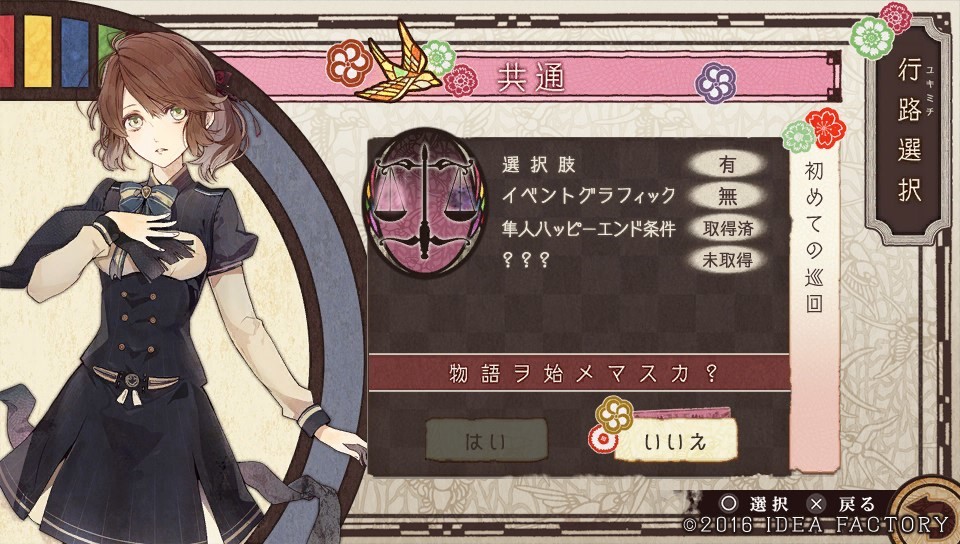
Concerning the Japanese level, I think the game is perfectly suited for intermediate learners. You have a lot of slice of life scenes mixed with some more complicated scenes, so it was overall a good learning experience for me!
Tone
Describing the tone is actually a bit difficult. Because it has elements of a coming of age story, following Tsugumi who hasn’t really left her home before discovering her independent side and spreading her wings, as Shiori, the warm mother figure in this game put it.
But she also says she wants Tsugumi to find a partner to spread her wings together with. I think overall the romance is very well paced. For some reason the game is famous for its smut, and I have to disagree with this. Though there are sexy scenes, they are not nearly as steamy as Olympia Soirée for example, but yeah, the characters do more than just kiss, but neither the CGs nor the descriptions can be called in any way explicit.
And then we have of course in every route a little murder mystery solving the book cases.
This way the game manages to strike a balance between heavier and lighter scenes making for a good pacing overall in my opinion.
In general I would describe this game as very subtle.
All the time there is this conflict between old and new, considering only old-fashioned hand written books can turn into devastating maremono and not printed ones. And of course there is the conflict between the old patriarchal system and the upcoming movements of women rights, not yet fully embraced in the taisho period. Especially that conflict is often spoken about in the routes with each of the characters supporting the mc in their own way, who is the focus and embodiment of this conflict, being raised with traditional values and almost secluded, to discovering the world for her own and often wishing she was born a boy. But those conflicts are not as apparent in the story as they are for example in OS, it’s more reading in between the lines.
And talking of reading. This is really a game for book lovers, not only because you visit libraries and many bookstores during your daily routine, but also because it is about the power of books to change your emotions and influence your actions. And this is a sentiment every book lover can relate to and that is slightly explored within the game. What would you do? Just burn all hand-written books destroying the thoughts and emotions the author poured into them forever or risk having more lives taken by those maremono?
Still as the scope of the game is relatively small, walking around looking for maremone, some parts can feel slightly repetitive. And What also is a recurring topic is the jealousy and possessiveness of literally every character. But in general I would still say the characters are very well fleshed out. That also applies to the sub-characters like the Fukurou mommy Shiori – i love her, she’s just the coolest person – or the mysterious Shokou and bright Tsubameno.
All those characters quickly made me feel at home at Nil Ado and let me deeply immerse in the story and world, finding my new home at the Fukurou.
Nil Admirari no Tenbin Kuroyuri: Enyoutan (Sequel/FD)
The sequel takes place one year after the happenings of the main game in a time where the conflict between the Japanese kingdom and the movement of anarchists is as it’s peak. Though there have been fewer incidents with maremono the times are not as peaceful as they seem. On top of the conflict with the anarchists, a criminal organisation might pose a threat to our loved characters. And other new wide characters entered the scenes, who also might have their secrets
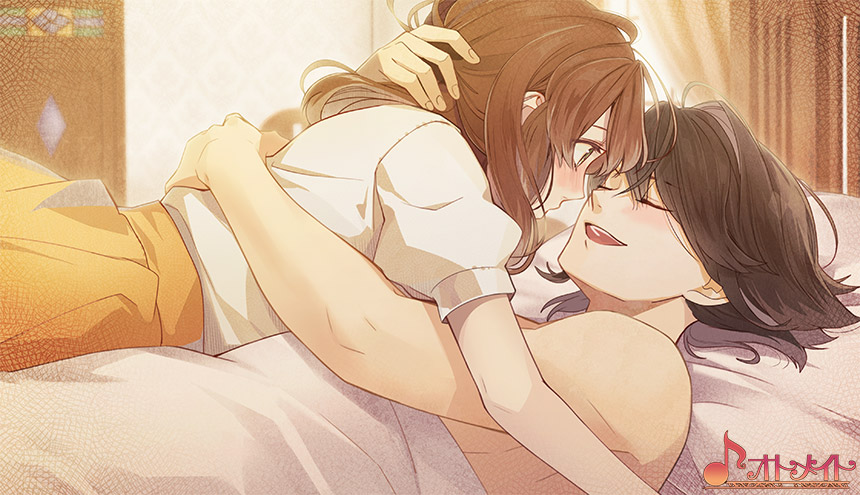
And the point is really – they developed!
Though the characters basically stayed the same, they all grew in their own way. Also the relationship became even closer, more mature and stable, by gaining more confidence in themselves and therefore also in the relationship. And that’s really nice to see, how they made even more room for meaningful character development.
With Shougo you continue your cute tsundere relationship, exploring more about the role of women in that time period and about the balance in life. In the sequel not only was Tsugumi possessed by the soul of a killed girl, on top of that another girl appeared claiming to be Shougo’s fiancée…
Hisui, who was in the main game looking for his mother, is in the sequel looking for his father, which again makes his story very heart-warming.
Akira and Tsugumi have a silent, but understanding relationship, though Akira continues to be slightly clumsy when it comes to matters of the heart and they have to figure out how to communicate their feelings in their relationship and feel worthy of each other. While his route in the original game was full of revelations and action, his route in the sequel was more calm, looking for the author of a forged maremono.
Rui stays a yandere light, but also has a personal emotional story to tell, and his story touches upon subjects like transgender identities!
The relationship with Shizuru grows even more mature and focuses on the conflict with the anarchists, discussing the relation of freedom and responsibility. And I felt like Tsugumi grew even more in this route.
But Hayato’s route faces even more moral predicaments, posing questions about life and death, as the city is threatened by an organisation, dealing opium and trafficking humans.
Concerning the art I don’t have much to add, compared to the original game, except for different loudness volumes of the voices or a reused voice of a character, but instead the CGs became prettier, less stiff, more dynamic and more frequent. On top of that almost every CG was a super super cute romantic CG.
What brings me to the next point: the romance in the sequel. And that’s why it is so difficult to tell, whether this is a FD, purely focused on romance, or a sequel with an actual plot, because the game has a lot of plot, a lot going on, many revelations in the story, that was even more interesting and diverse than in the main game and the pacing was also way better.
But at the same time, all the routes are soo romantic. I believe that might have been the most romantic game I’ve ever played. I now would also say that it could be called smut a bit more, though I still argue, its still on no way offensive, but simply sexy scenes. The sugar content is immensely high. You will be satisfied. And the good endings are incredibly wholesome.
What also intensified are the bad endings. They are on a whole new level compared to the original game. They are extremely tragic, sad, cruel and straight out sickening, much comparable to the endings in OS.
All in all better writing, romance, story, wraps up plot holes and loose ends.
Though honestly they didn’t bother me much in the original game, but in direct comparison the sequel definitely makes a lot of things better than the original.
Extras
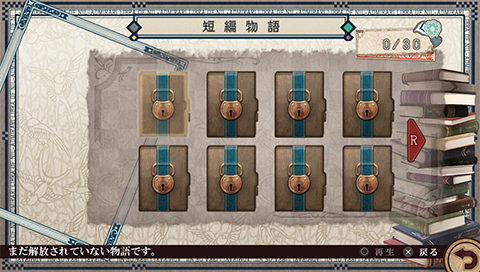
The Switch version comes with the original and sequel combined.
On top of a classical talking menu (hearing character’s voices, whenever you click in the menu) there are a few chapters of after stories for each character, including the sub characters.
Each character has a good and bad ending and sometimes sudden in-between endings, but with love capture most of the time, it’s not too hard to figure out.
So in conclusion, is Nil Admirari comparable to Olympia Soirée?
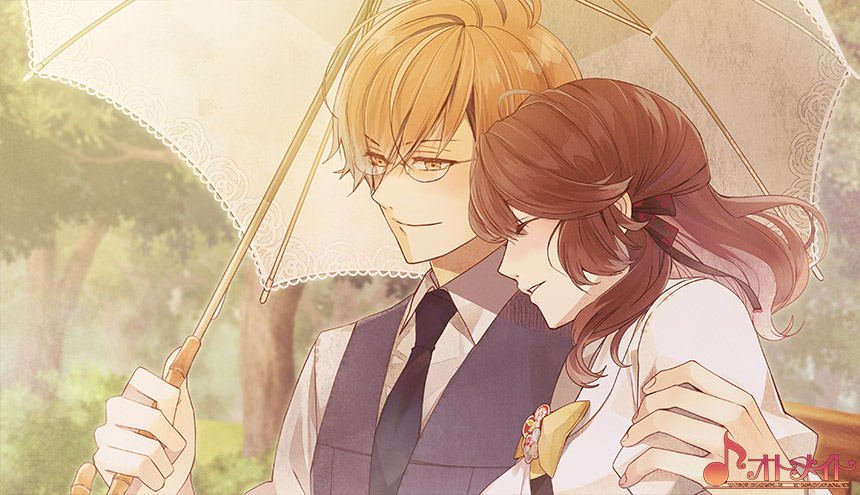
I would say, yes, very much.
Instead of the daily letter delivery you have the daily search for maremono in the main game of Nil Admirari. You have the Mc that grows from being a sheltered bird to becoming a self-confident woman, though this development is more pronounced in OS.
What OS also is known for is world building. As Nil Admirari has no fantasy setting, it doesn’t do as much world building, but what it does brilliantly is character building. With each route in either game you discover more about the characters, not only the main characters, but especially the interesting, deep and sometimes messed up side characters, and how they are connected to what happens in the world and how they fit into the network of characters and influence each other behind the scenes, and it’s up to you to slowly unravel the truth behind all of them.
But as I said in the tone section of the main game, Nil Admirari feels more subtle than OS, but nevertheless explores many moral problems and is a game of antithesis,
good and evil,
old and new,
feminism and patriarchy,
imperialism and anarchism,
freedom and responsibility,
trust and treason,
revenge and forgiveness,
life and death,
hate and above all what it means to truly love.

“That was a helpful review!
To show my appreciation I’m gonna purchase it via Lin’s amazon link to support her!”
